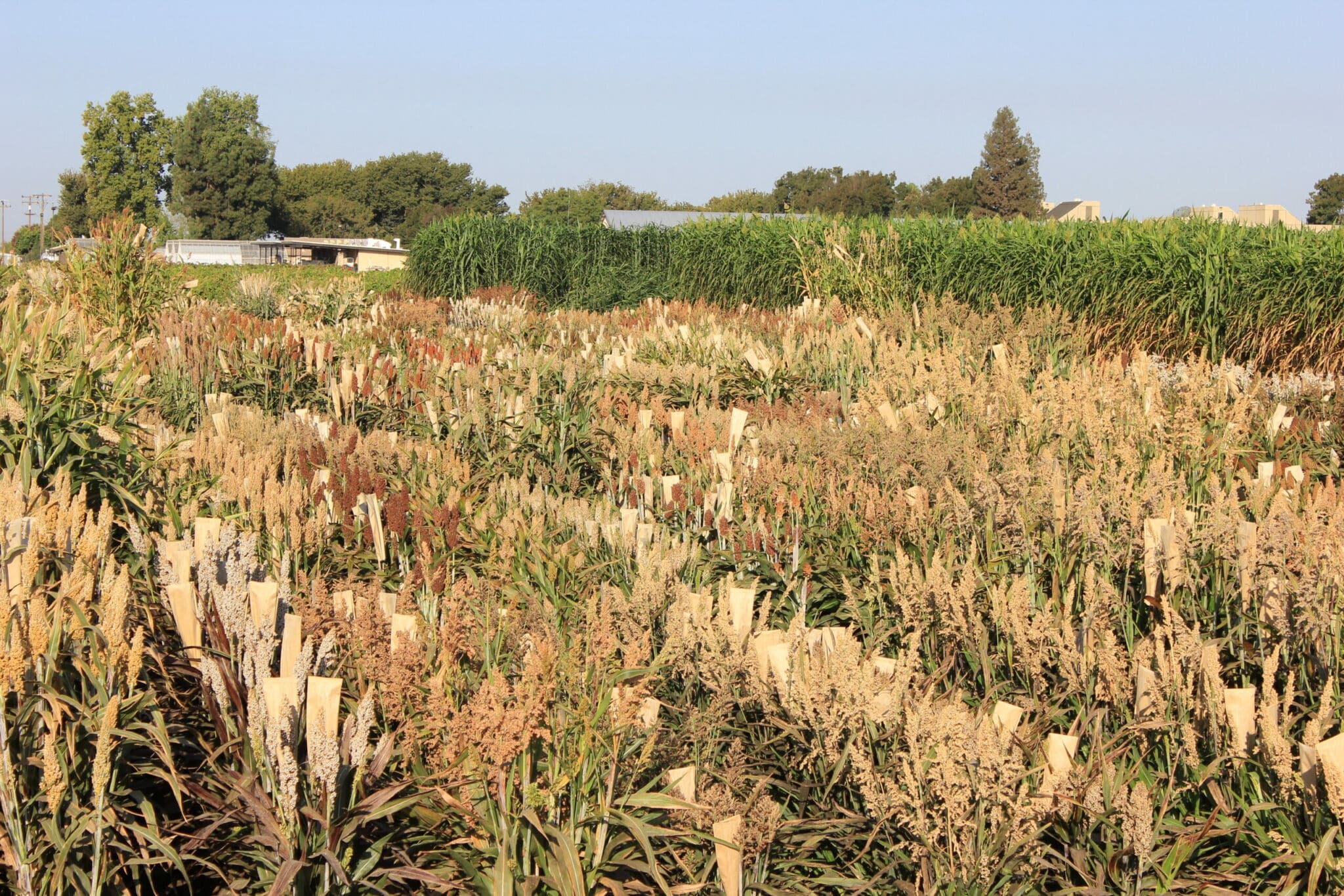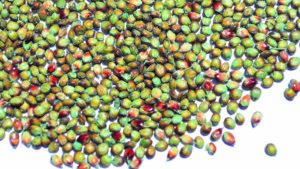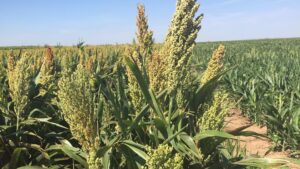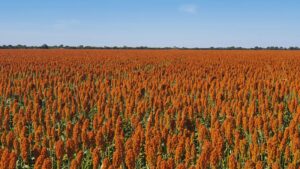Finding more genetic diversity in sorghum is an investment today that will payout in the long run.
For Sarah Sexton-Bowser, managing director for the Center for Sorghum Improvement, genetic diversity in cash-crop germplasm is analogous to a retirement portfolio. She shares that an investment in crop diversity today will pay dividends in the future.
“When I think about the crops I plant on my farm or the types of investments I help farmers make in sorghum as a crop, it isn’t a lot different than my retirement investment portfolio,” she says. “We need to be investing in and developing sorghum genetics that have near-term deliverables, understanding how sorghum as a crop is best managed and fits into a cropping system for sustainability, and also targeting what longer-term investments in genetic improvement will provide.”
A seemingly less popular crop, with historically lower research funding in relation to corn and soybeans, grain sorghum holds a wealth of untapped potential for not only the farmer, but for the livestock feed and human consumption markets, as well.
Genetic diversity in a plant population is important for a host of reasons and is paramount to preservation, performance and stewardship in an agricultural system. Genetic diversity amongst accessions allows a timely response to new pests and diseases that may arise in the U.S. crop by allowing researchers the flexibility of looking at several pools of genetic lines when searching for resistance.
Today, the U.S. Department of Agriculture (USDA), Plant Genetic Resources Conservation Unit located in Griffin, Ga., is home to over 100,000 accessions of preserved plant germplasm including the largest collection of sorghum germplasm in the world. Of the 100,000 more than 40% are sorghum; a fact Unit Research Leader, Melanie Harrison attributes to the crops increasing popularity.
“Sorghum is just one of the crops that we maintain at this location, but we have over 45,000 unique populations of sorghum that we maintain,” she says. “And, on average, we distribute between 10,000-12,000 accessions of sorghum a year.”
Making a Case for Diversity
Aside from being a timely response mechanism to counter diseases and pests, genetic diversity within the sorghum species is also beneficial to the bottom line of a producer.
Sexton-Bowser says that the use of diversity, in combination with technology and data, can provide greater leverage for the farming community than any of the three used as a stand-alone solution. Finding the right combination of genetic diversity, technology and data is a goal the Collaborative Sorghum Investment Program (CSIP) continues to strive for.
“We each only have so many opportunities to roll the dice in making improvements in the crops that we grow, the average farmer has around 50 growing seasons that they will help manage,” she says. “So how do we best advantage our crop improvement programs?

“We talk about big data and then we start to break down that conversation and decipher the value of that data and the ability of those that work in crop breeding and genetics to take and parametrize their observations realistically: to the actual environments and fields that farmers will be managing their technologies with. That allows us to make much more efficient gains in taking this vast pool of genetic diversity that today we really aren’t fully exploiting to help farmers.
“What’s in the seed bag is important to farmers,” Sexton-Bowser says. “The critical role in working with genetic improvement is the need to prioritize. Certainly there is vast opportunity, but the need to identify and prioritize is crucial to moving products out the door and developing them into a valuable technology that goes into the seed bag.”
That is what the CSIP project works to do: create momentum in the intersection between the innovation and practical, field level application.
Challenges of Increasing Genetic Diversity
As part of the USDA Agriculture Research Service, National Plant Germplasm System, the Plant Genetic Resources Conservation Unit preserves the largest sorghum germplasm collection in the world. Unfortunately, fewer than half have been genotyped.
“Of the 40,000 plus accessions of sorghum we currently have in preservation in our national seed bank, 85% or higher are photo sensitive,” says Jeff Dahlberg, director of the University of California’s Kearney Agricultural Research and Exension Center. “We have no idea what potential benefits those accessions hold because they have not been photo-period converted to grow in temperate climates. Of the 40,000 plus, I would be surprised if we were using over 100 of those genetic lines in our cropping systems.”
One of the greatest challenges facing sorghum’s genetic diversity is the time it takes for a genetic line to progress through the conversion process. As a crop that was first domesticated in Africa, sorghum requires a tropical environment, with short day lengths, to flower — a requirement prohibitive of growth in the U.S. temperate zones.
During the 1960s, an effort began to convert tropical, photo period sensitive lines to photo period insensitive lines, so that the plants would flower in the United States. The conversions used accessions collected by academics as well as distributions provided by the National Plant Germplasm System. The process of conversion of exotic material to materials useable by breeding programs is long and tedious. To generate a sorghum type with the wild diversity in a short, photo period sensitive plant, multiple cycles of grow out and selection are utilized. The long and tedious process, still in use today, crosses exotic parent plants in Puerto Rico; after harvest, seed from the cross is sent to Texas where it is grown out. During the U.S. growing season, selection pressure is directed toward short, flowering plants. The plant selections are then sent back to Puerto Rico to create crosses to the genetic parents again. The process was repeated until a plant that resembled and mimicked the exotic parent was produced: short plant height and did not require short days to flower. The conversion process, although not time efficient, did allow U.S. farmers to begin looking at sorghum lines from around the world and the benefits that exotic sorghum genetics could potentially provide.
Additional challenges to the genetic diversity of sorghum, Dahlberg speculates, may be present in the consolidation of the largest sorghum seed companies.
“A big concern is the consolidation of seed companies,” he says. “There are fewer and fewer seed companies in sorghum. Depending on the genetic pools that each of the companies have, they may be narrowing the genetic pool of sorghum seed in the country — it really depends on how diverse the pool of inbred lines is that companies are working with.”
Opportunities for Sorghum Abound
Today, the opportunities for sorghum seem to far outweigh the crop’s challenges and limitations, despite the technology advantages held by other crops.
While the technology of transgenic modification has allowed corn and soybeans to dominate acres across the United States, it will likely not hold the same opportunity for sorghum, Dahlberg suggests.
Transgenic modification isn’t the only technology on the horizon for the genetic improvement of sorghum. Dahlberg says that gene editing could be beneficial to enhancing genetic improvement in the crop.
“If we know what gene to turn off, we can make a plant photo period insensitive and convert exotic lines in a year or two, rather than seven or eight,” he says. “We would also be able to maintain almost all of the exotic germplasm which will, ultimately, give us more genotypes to look at.”
Sexton-Bowser also shares that sorghum offers untapped benefits because of the types of environments and ecologies accessions are generated from. She notes that while the agriculture industry has made considerable genetic gain in both corn and soybeans, there has been less selection pressure and fewer resources dedicated to the sorghum crop — providing much more unexploited genetic potential to be mobilized as technology in the seed bag for U.S. famers.
“The one thing that we all need to remember about genetic improvement within a crop is that there is a give-and-take system of trade-offs,” she says. “As you make more advanced genetic gains on a certain crop, you are potentially foregoing future opportunities and diversity. It’s all about balance as we build out a pipeline for sorghum that can put into play the genetic diversity that we aren’t leveraging today.”













